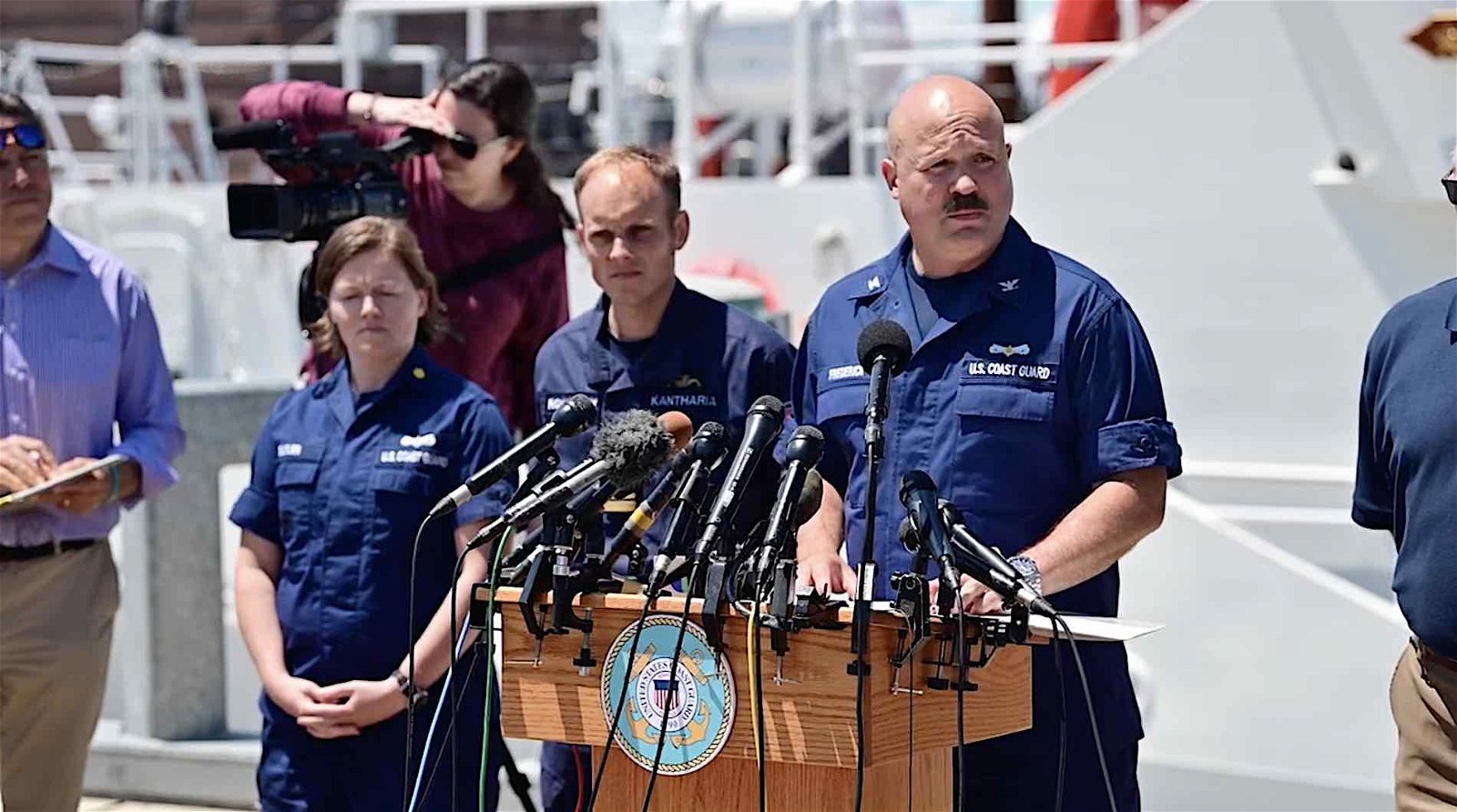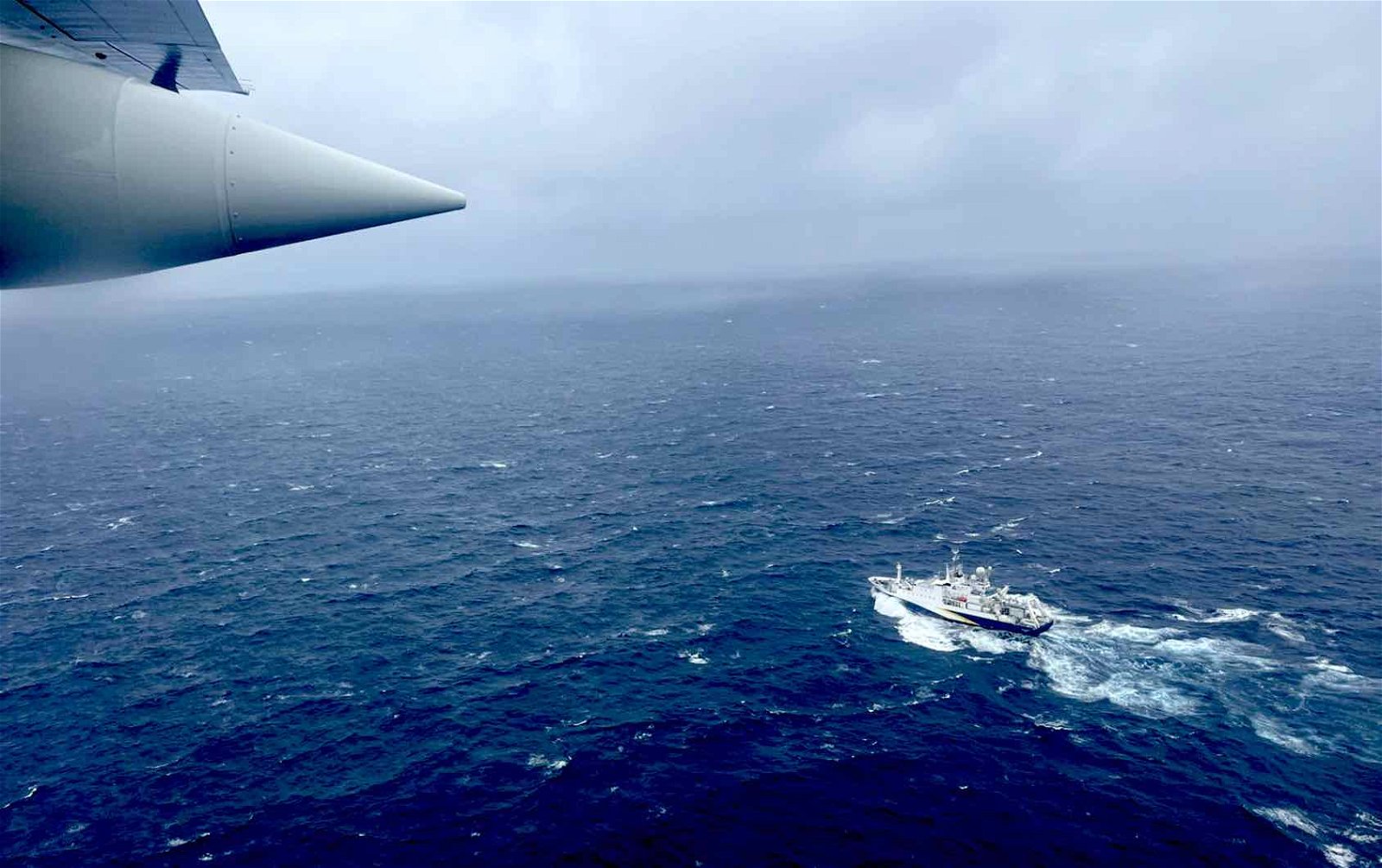

Welcome to this week’s installment of The Intelligence Brief… as the search for a missing submersible has captured the world’s attention, this week we’ll be analyzing the rescue effort and examining 1) what we currently know about the search for Titan and 2) the company behind the missing vessel, as well as 3) what U.S. Coast Guard and those assisting it have found, and 4) potentially breaking developments in the Rescue Effort.
Quote of the Week:
“Man has only to sink beneath the surface and he is free.”
– Jacques Yves Cousteau
Latest Stories: Some of the stories we’re covering this week at The Debrief include how a team of Canadian researchers says that the lack of clumpiness in the structure of the universe could help to shed new light on the composition of dark matter. Also, The Galileo Project’s expedition to retrieve fragments from an interstellar meteor continues, as documented in the recent installments of Avi Loeb’s “Diary of an Interstellar Journey.” You will find links to all our latest stories at the end of this week’s newsletter.
Podcasts: This week in podcasts from The Debrief, MJ Banias and Stephanie Gerk discuss whether ChatGPT will really be good for humanity, and much more in the latest installment of The Debrief Weekly Report. Meanwhile, this week on The Micah Hanks Program, we look at the connections between UAP and nuclear sites in an in-depth discussion with researcher Larry Hancock. You can subscribe to all of The Debrief’s podcasts, including audio editions of Rebelliously Curious, by heading over to our Podcasts Page.
Video News: Recently, on Rebelliously Curious, Chrissy Newton talks with Thomas Olson, Director of Business Development with Avealto, a company developing high-altitude wireless platforms designed to provide communication services to unserved and underserved regions of the world. Also, in the latest installment of our new series “Ask Dr. Chance” premiering this Friday, the Good Doctor catches up with Tim Russ from Star Trek for a discussion about science fiction and space exploration. You can also watch past episodes and other great content from The Debrief on our official YouTube Channel.
With all the housekeeping behind us, it’s time to turn our attention to the current situation developing with regard to the missing submersible Titan and what the U.S. Coast Guard may be planning to reveal later this afternoon about what the search effort has yielded.
Desperate Search Ensues for a Missing Submersible
Since late Sunday, the search for Titan, a missing submersible research vessel that vanished while on its way to view the wreckage of the famous sunken Titanic, has captured the world’s attention as a desperate effort to recover the lost vessel before its five-person crew loses oxygen has remained underway.
The search effort, led by the United States Coast Guard with assistance from international partners, has focused on an area approximately 900 miles off the coast of Cape Cod, Massachusetts, since the small submersible was reported lost after a Canadian research ship, the MV Polar Prince, lost contact with the craft and its crew.


Hopes that the passengers could be saved have dwindled amidst reports that the vessel’s oxygen levels would likely be incapable of supporting its crew beyond Thursday morning, despite reports in recent days of banging sounds detected by sonar devices.
As efforts continue to attempt to locate the 21-foot submersible, several questions remain about what circumstances might have led to its disappearance. So what do we currently know about the search for Titan, as well as the company behind the missing vessel, what the U.S. Coast Guard and those assisting in the effort have found, and the likelihood at this point that rescue attempts might still succeed?
SHIPS AND PLANES FROM MANY NATIONS
On Wednesday, the U.S. Coast Guard issued an update on the search for the Titan, stating that several ships equipped with sonar and search aircraft have been deployed in the effort. These include three Canadian vessels, the CGS Ann Harvey, CGS Terry Fox, and the Glace Bay, which is equipped with medical personnel and a mobile decompression chamber.
A French Research Vessel, L’Atalante, and several other craft were also deployed to the area. Canadian Coast Guard vessels also arrived on the scene on Wednesday.


“The Canadian Coast Guard boat John Cabot, a vessel with sonar capabilities, arrived on-scene Wednesday morning along with commercial vessels Skandi Vinland and the Atlantic Merlin,” the U.S. Coast Guard said, adding that one of its own C-130 aircraft had carried a Coast Guard crew to the scene to assist in the search.
“Underwater sounds have been detected in the search area, resulting in the redirection of remotely operated vehicle (ROV) operations to explore the origin,” the Coast Guard said. “These recordings have been shared with the U.S. Navy for analysis to help guide future search efforts.”
This morning, additional ROVs were deployed to assist in the deep Atlantic search for the Titan around one of the world’s most famous ship wreckage sites.
OceanGate Expeditions
Titan is a submersible owned by the Everett, Washington-based company OceanGate Expeditions. Founded in 2009 by Stockton Rush, the company has endeavored to make deep-ocean exploration more accessible by providing submersibles for underwater expeditions, tourism to underwater shipwrecks, and also crewed vessels for both scientific and commercial projects.
Rush, who is the company’s CEO and founder, is a pilot and aerospace engineer who, by age 19, had succeeded in becoming the youngest jet transport-rated pilot.
“Our team of qualified pilots, expedition leaders, mission professionals and client-service staff ensure accountability throughout the entire mission and expedition process with a focus on safety, proactive communication and client satisfaction,” the OceanGate Expeditions website states. As of Thursday morning, the company’s site was experiencing periodic timeouts due to the attention it has received since Titan was reported missing on Sunday evening.
Currently, the company has three submersibles capable of carrying five-person crews into the ocean depths. Since 2021, the company has been offering tours of the Titanic wreckage site. An earlier attempt in 2018 was canceled after Titan’s electronics were damaged, followed by a second postponement in 2019 due to complications arising from Canadian maritime law.
Prior to its descent to the Titanic wreckage in 2021, Titan was rebuilt with assistance from NASA’s Marshall Space Flight Center after it was determined that the vessel’s depth rating was not deemed strong enough for travel to the 12,500-foot depth where the famous sunken British passenger liner rests.
The Debris Field: What the Search Effort Has Found So Far
Amidst poor weather that hampered search efforts on Wednesday, hopes remained as reports of “banging” sounds were detected by sonar operators.
CNN reported that according to an internal U.S. government memo related to the search, the strange banging noises had been heard every 30 minutes and were continuously detected following the deployment of additional ROVs.
However, on Thursday morning, a day cited as “critical” in terms of the likelihood that oxygen levels present on board the craft remained capable of supporting any surviving crew members, the U.S. First Coast Guard District announced on Twitter that a “debris field was discovered within the search area by an ROV near the Titanic.”


“Experts within the unified command are evaluating the information,” the Twitter post read.
Today at 3 PM Eastern, the U.S. Coast Guard is expected to hold a press briefing with additional details about their evaluation of the apparent debris field and other updates on the search effort.
That concludes this week’s installment of The Intelligence Brief. You can read past editions of The Intelligence Brief at our website, or if you found this installment online, don’t forget to subscribe and get future email editions from us here. Also, if you have a tip or other information you’d like to send along directly to me, you can email me at micah [@] thedebrief [dot] org, or Tweet at me @MicahHanks.


Here are the top stories we’re covering right now…
- Diary of an Interstellar Voyage: Parts 18-20 (June 21, 2023) The Discovery of Spherules from the Path of the First Recognized Interstellar Meteor, IM1
Magnetic spherules are detected under the microscope by Avi Loeb and the Galileo Project team in this latest installment of ‘Diary of an Interstellar Voyage.’
- Astronomers, Scientists, and Experts Convene in Paris, France, to Study Aerial Mysteries
A recent conference in Paris, France, brought together leading scientists to delve into the study of unidentified aerial phenomena (UAP).
- “Essential for Life” Amino Acid Found in Interstellar Space, Increasing Chances Extraterrestrial Life is Common
A Spanish researcher who has previously discovered water, carbon dioxide and other key life-supporting chemicals in an interstellar region of space where planets and stars are born says she has now found the life-supporting amino acid tryptophan in the same place.
- TRAPPIST-1 Could Have Lower Number of Habitable Planets, New Webb Data Suggests
New data from the James Webb Space Telescope (JWST) suggests an exoplanet with once-promising potential for life shows no signs of having a thick atmosphere.
- Rescue Teams Race Against Time in Search for Missing Submersible Near Titanic Wreck
The search for a submersible craft with five people aboard remains underway after disappearing near the wreckage of the famous Titanic.
- Diary of an Interstellar Voyage: Parts 14-17 (June 19-20, 2023) Corroded Iron and Volcanic Debris in IM1’s Path
Corroded iron, volcanic debris, and evidence of magnetic particles turn up in IM1’s Path in this latest update from the Galileo Project’s expedition.
- Theoretical Breakthrough Could Finally Solve the Mystery of Invisible Dark Matter
A team of Canadian researchers says that the lack of clumpiness in the structure of the universe could help to shed new light on the composition of dark matter.
- Diary of an Interstellar Voyage, Parts 11-13: June 18, 2023
More materials are recovered, and new questions surface, in this combined three-part entry covering Day 8 (June 18, 2023) of the Galileo Project team’s expedition.
- New Phase of Matter Revealed in Physics Breakthrough By Scientists Who Engineered a “Frustration Machine”
A new phase of matter has been discovered by a team of physicists who succeeded in engineering what they call a “frustration machine.”
- Diary of an Interstellar Voyage, Parts 9 & 10: June 17, 2023 You Can’t Make a Lemonade Without Lemons
The Galileo Project continues its recovery of material from the ocean floor during its expedition to recover an interstellar object off the coast of Papua New Guinea.
- What’s That Orbiting the Moon? Data Suggests a Lost Spacecraft Could be Lurking in Lunar Orbit
Recent calculations suggest a famous “lost” spacecraft could have been hiding for decades in orbit around the moon.
- Does ChatGPT Really Want to Save Humanity, or is This a Trap? This week on The Debrief Weekly Report…
SUBSCRIBE TO ‘THE DEBRIEF WEEKLY REPORT’: Apple Podcasts | Spotify On today’s episode, NASA’s Parker Solar Probe made its closest run at the Sun scanning for solar winds, scientists believe there are more Earth-like planets out there than we think, and ChapGPT built a tomato picking robot to save humanity from collapse. You can listen to the episode on Apple Podcasts, Spotify, by asking your AI, or simply download it wherever you get your podcasts. Please make sure to click ‘Subscribe’ […]
- Diary of an Interstellar Voyage: Parts 7 & 8 Strange Wires and Diverse Fragments in the Pacific Ocean Site of the First Interstellar Meteor
Strange Wires and other fragments are found during the Galileo Project’s expedition to recover an interstellar object from the ocean floor.
- Newly Revealed Speed of Fastest Stars Ever Observed in the Milky Way Stuns Astronomers
An international team of astronomers reports they have succeeded in detecting the fastest stars ever observed within the Milky Way galaxy.
- Diary of an Interstellar Voyage: Parts 5 & 6 First Sample of Fragments from the Pacific Ocean Floor
This combined entry covers Days 5 and 6 of the Galileo Project’s expedition to recover a interstellar object from the Pacific Ocean floor.
- DARPA and NASA’s Jet Propulsion Lab Unite to Combat File Format Dangers with ‘SafeDocs’
DARPA and JPL team up with the SafeDocs program to provide new tools that allow safe access to online documents.
- Phosphates Found in Ocean of Saturn’s Moon Enceladus Dramatically Increase Chances for Life
Organic phosphates have been found spewing from the subsurface ocean of Saturn’s moon Enceladus, increasing its chances of hosting life.
- David Grusch: The UAP Whistleblower Controversy
As the story of UAP whistleblower David Grusch continues to unfold, statements from the former IC official have erupted in controversy.
- New Bill Directs FAA to Track Airborne Objects That May Pose Collision Threat to Aviators
A new bill introduced by the House Transportation and Infrastructure Committee includes language that will task the Federal Aviation Administration (FAA) with tracking objects deemed to be a risk resulting from airborne debris.
- Diary of an Interstellar Journey: Part 4 Scooping the Ocean Floor
Scooping the Ocean Floor: The Galileo Project team’s magnetic sled is lowered to bottom of the Pacific in the fourth installment of “Diary of an Interstellar Journey.”